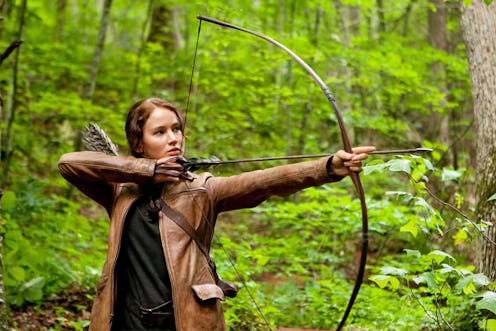
With the success of franchises like The Hunger Games and Divergent, we’re now firmly in the age of the gritty, tough, dystopian female heroine. Hoorah! Accordingly, toy companies have begun marketing bows and arrows and other such playthings to girls — with one caveat: All these pieces of play-weaponry are still overwhelmingly pink. And I’m not the only one that finds this trend as troubling as I find it encouraging.
In the New York Times, Hilary Stout and Elizabeth A. Harris write about the emergence of toys like the Nerf Rebelle line and the Zing Air Huntress bows and slingshots, as “a selection… that, oddly, both challenges antiquated notions and plays to them deeply.” Although a lot of parents these days are (perhaps understandably) a little uneasy about play violence, it’s not necessarily bad for them; as child psychologist Sharon Lamb told Stout and Harris, toys that stimulate aggression are actually healthy for kids. As such, she sees the good side of these new girly weapons: “I don’t see this as making girls more aggressive, but instead as letting girls know that their aggressive impulses are acceptable and they should be able to play them out.”
She also, however, questions the “stereotyped girlifying” of them — and I’ve got to say, I definitely agree. With Katniss, Tris, Merida of Brave, and even The Avengers’ Natasha “Black Widow” Romanov (awful Captain America 2: The Winter Soldier poster aside) now being held up as role models for girls, ladies who kick butt are offering strong examples to follow. None of these women, however, are pink. So why are all the toys capitalizing on their popularity still the color of Barbie’s Malibu Dreamhouse?
“Pinkification” is a relatively new phenomenon. As Peggy Orenstein writes in Cinderella Ate My Daughter (which, by the way, you should all read ASAP), this whole "color-coding of childhood" thing didn’t start happening until the early twentieth century. In the pre-washing machine era, all babies were dressed in white due to the fact that white clothing is easier to clean (let’s face it: babies are messy); when nurseries started getting colorful, pink was actually considered to be a paler version of red and therefore more masculine. But in recent decades, “girly” toys that used to come in more neutral colors — teal or blue, like the original Easy Bake Oven, for example — have made the shift over into the pink zone, which is increasingly becoming a problem.
And it’s not so much the pink itself that’s the problem; it’s the fact that pink is seemingly the only option marketing specifically at girls now. When the mother of a seven-year-old girl told the Times that she doesn’t mind the pinkness — “That’s who she is—girl and sparkles and loves to sneak my makeup, but loves the hero and being in charge” — I can get behind the image. But what about the girls who don’t want pink? Why is it being thrust upon them anyway?
At least strides are being made in the other direction — Hasbro, for example, heeded a little boy’s plea for a gender-neutral Easy Bake Oven color option, making way for the future Dominique Ansels of the world to hop on the baking bandwagon early. I’m sure girls are also thrilled to have the choice between silver and pinky-purple, too — I know I would have been at that age.
I appreciate what Hasbro’s chief marketing officer, John A. Frasotti, told Stout and Harris for their article — that “It’s the coming age of the Title IX mom, who grew up as an athlete in her own right,” as well as that “men, who have grown up in that environment… want their children, boys and girls, to have equal opportunity to play” — but I think we’ve still got a long way to go yet. Ah well; at least maybe we’ve reached the furthest the pendulum can swing in one direction. If pink bows are the beginning of the pendulum taking a different direction, at least it’s a start.
Image: Lionsgate